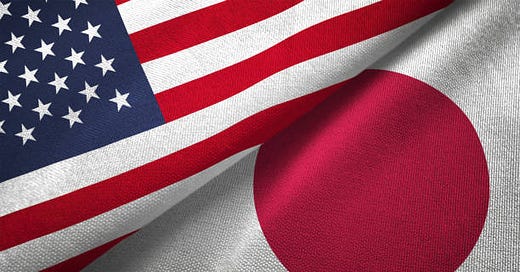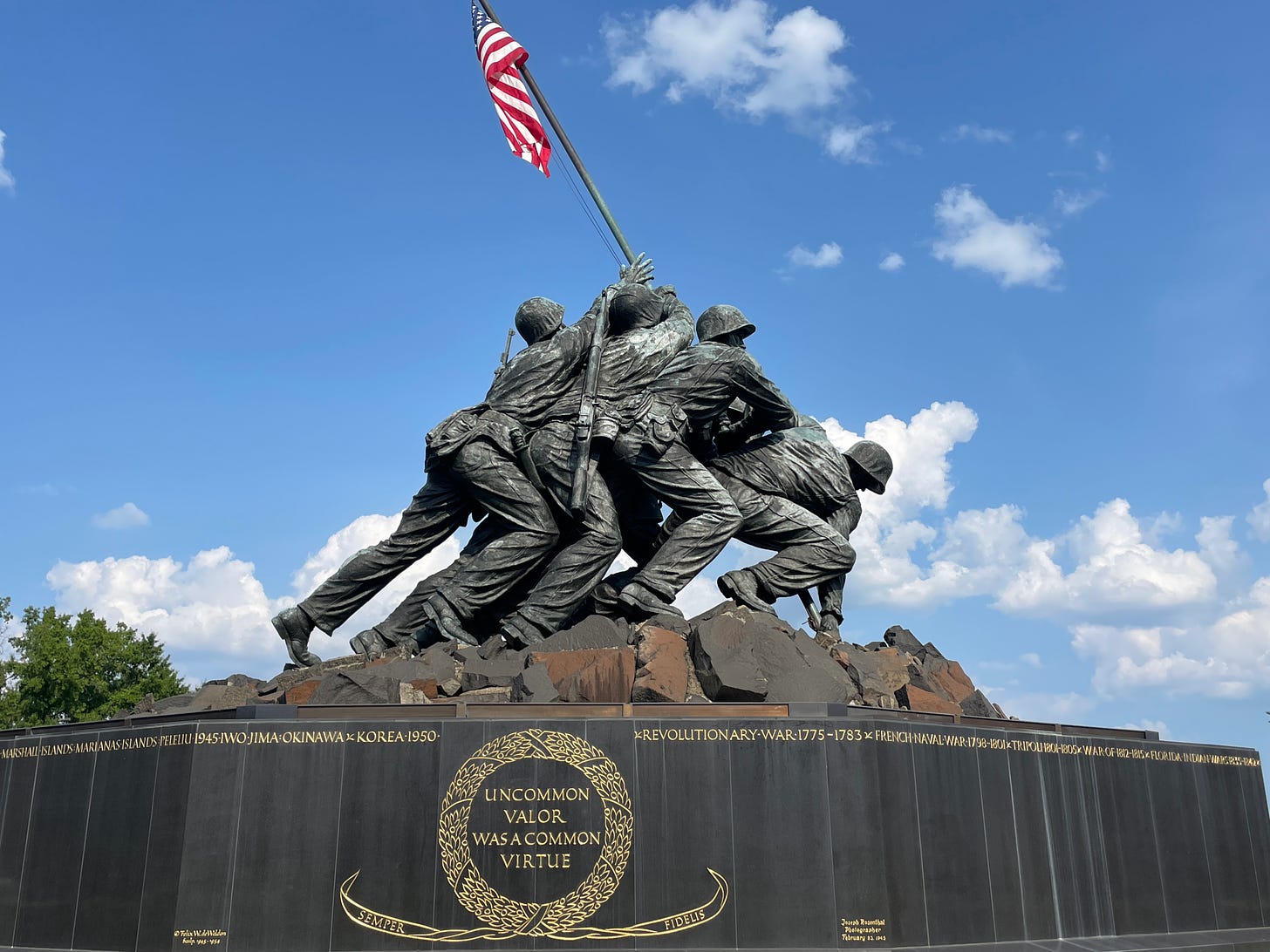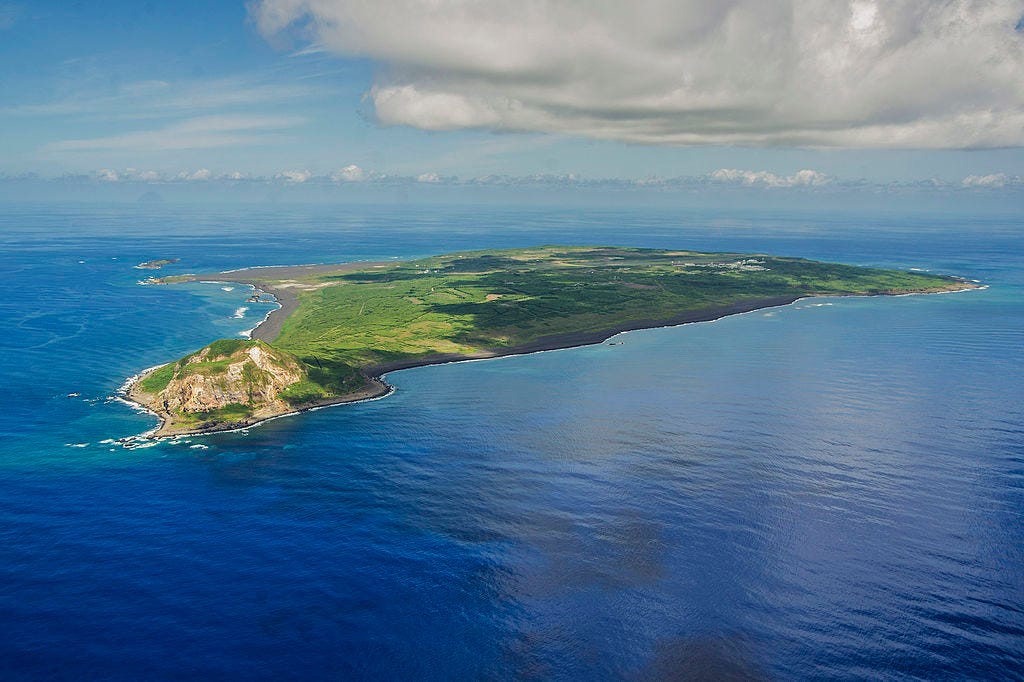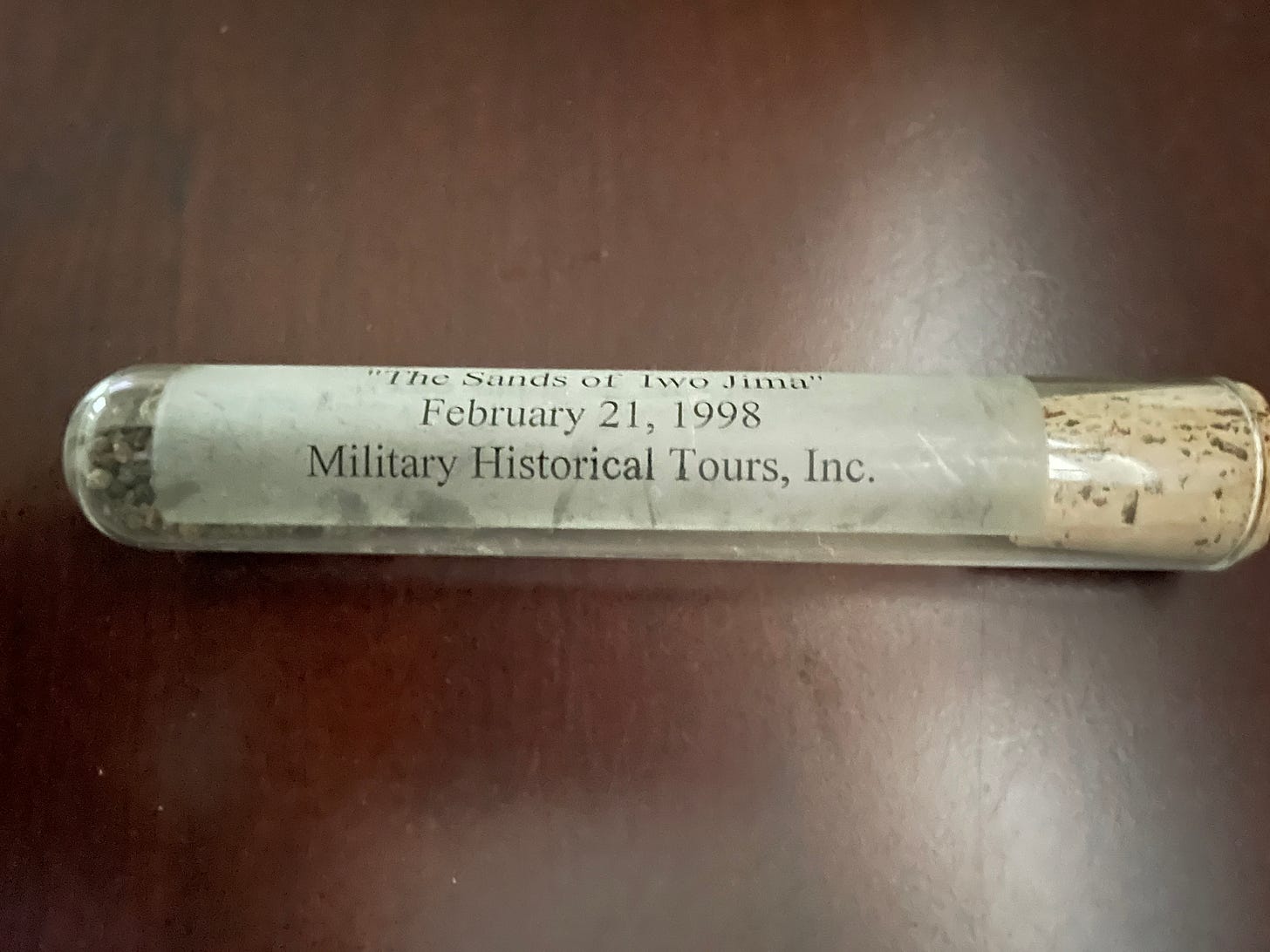Iwo Jima: A Memory of a Stark War Story Suddenly Recalled
Never Before Spoken and Probably Never Again
It’s no mystery why some of our most impactful memories consist of the stories of others. We’re a composite in that sense, and contain multitudes. We absorb the joys and the perils, the good times and close calls of family, friends, and even perfect strangers who may have lived more fully, more meaningfully, closer to the edge than we ever did. This certainly applies to the memory I most remember from my trip to Iwo Jima in February 1998 with a group of surviving veterans from that harrowing WWII battle. The stark story of one veteran in particular, triggered by his physical presence on far away “Sulfur Island” for the first time in more than fifty years. How can I forget?
It was a wonder we got to Iwo Jima at all that year. The 50th anniversary commemoration event had taken place on the island the year before I arrived to the US Embassy in Tokyo in 1996 as a political-military officer. I recall perusing the files left by my predecessor, and musing about the missed opportunity. I certainly didn’t think much would come of the effort to organize a smaller-scale, make-up event for the handful of surviving veterans and their family members who had missed the big one the year before. I was wrong.
Full disclosure: Before going, I hadn’t quite understood the historical importance of Iwo Jima or grasped the horrific nature of the fighting that took place there February 19 - March 26, 1945. I’ve since tried to make up for that gap in my knowledge by reading articles, reviewing historical clips, and even watching Hollywood movies. The latter category includes Clint Eastwood’s groundbreaking 2006 duo of films— Letters from Iwo Jima and Flags of Our Fathers—featuring dueling Japanese and American perspectives, which I highly recommend.
*****
But for those like me who need a brief historical refresher, here goes. After the United States entered the Second World War on December 7, 1941, US forces had begun the fight in the Pacific theater deep in the South Pacific in such mythical-sounding places as Guadalcanal in the Solomon Islands. From there, engaged in pitched, island to island combat against entrenched Japanese resistance, they pushed inexorably northward toward mainland Japan. After three intensive and exhausting years of perilous fighting, the assault on Iwo Jima would be the first time US forces would do battle on Japanese soil.
US military leaders knew our invading forces would face fierce, fight-to-the-death resistance for that reason, even if they didn’t quite comprehend in advance the degree to which this would be true. For one, the precise number of Japanese troops on the island was not known and their presence was mostly invisible—hidden in so-called pillboxes (camouflaged guard posts carved into the rocks), subsurface bunkers, and a massive island-wide network of caves and tunnels dug deep underground. Many first-hand accounts note that US forces only rarely saw the Japanese enemy, who emerged above ground to attack mostly at night.
Iwo Jima’s airfield was the island’s strategic grand prize. Once under US control, US forces could use it to facilitate the subsequent invasion of mainland Japan about 750 miles away. In that sense, control of the island would mean turning the corner on the final phase of the war. More than 6,000 US Marines were killed during the brutal five-week assault, and another 20,000 were wounded. Of the roughly 18,000 Japanese soldiers stationed on Iwo Jima at the time, according to historical accounts, only 216 survived. We can leave to the side for now the debate among military historians about the costs vs benefits of taking Iwo Jima, reports that Marine Corps leadership had not been consulted before the assault, or the fact that the Navy’s bombing campaign to “soften” Japanese positions was cut ineffectively short to just three days.
*****
My role then was to coordinate US plans and activities with our Japanese Foreign Ministry and Defense Agency counterparts. Whatever we Americans wanted to do in Japan, our Japanese friends would be leading the way. It was also fitting and proper that any WWII commemoration taking place on Japan’s national territory should involve veterans and representatives from both sides. Besides, we former enemies were formal treaty allies now. Things change. They still do today.
Our group consisted of twenty odd surviving US veterans and their family members, several military historical tour guides (themselves retired military officers), and two or three active-duty military handlers and diplomats like me. We landed mid-morning at Iwo Jima’s Japan Air Self-Defense Force airstrip and traveled in a short convoy of vans to the top of Mount Suribachi—of flag-raising and Iwo Jima Memorial fame. Up on the bluff, with a panoramic view of the Pacific, we conducted a brief ceremony alongside our Japanese counterparts. Solemn words about valor, honor, fate, and a distant political struggle now past were spoken. American and Japanese veterans—most of them elderly by then—exchanged greetings and shook one another’s hands. They may have been trying to kill one another before, but they were brothers in arms and old friends now.
*****
What first strikes one about Iwo Jima is just how tiny it is. An islet less than five miles long and three miles wide, rocky and mostly flat for the bulk of its length and breadth, the squat, semi-active volcano of Mount Suribachi rises like the head of a turtle 500 feet above sea level on its southern tip. Unlike the beaches and cliffs of Normandy that connect to the European continent, one wonders how such an infinitesimal dot in the middle of the Pacific might be worth such a fierce, deadly fight? But the rusting carcasses of abandoned war ships and materiel still stranded off Iwo Jima’s shore reminded one that it really had been, however puzzling and anachronistic it might seem to us now.
One of the veterans in our group had been a military photographer. (Preempting the question, he said he had overlapped for several days on the island with Joe Rosenthal, the Pulitzer Prize winner from the Associated Press who took the famous photo). There for the first time in over 50 years, the photographer recalled seeing Iwo Jima’s rocky surface carpeted by the bloodied bodies of dead and injured Marines, to such a degree that it was hard to avoid stepping on them. Shaking his head at the memory, another veteran remembered survivors resorting to outbursts of black humor to relieve the pressure of the unimaginable scene: “When you die, I’m going piss on your body.” “Oh yeah,” another responded, “when you die, I’m going to shit on yours.”
What strikes one even more is the pungent smell of sulfur pervading the air and the jets of sulfurous steam rising from the crevices of the island’s underground hot springs. (Not for nothing does Iwo Jima mean “Sulfur Island” in Japanese, its volcanic origins more palpable to the senses than anywhere else I’ve ever been). Several of us were able to climb down into the mouth and throat of a partly reconstructed underground tunnel to experience, if only momentarily, the hellish heat and claustrophobic conditions down there. While historical accounts note that many Japanese soldiers were killed by bullets, grenades and flamethrower fire, one veteran recalled another less mentioned cause of Japanese death: thirst. Trapped in their sauna-like tunnels, Japanese soldiers were at the mercy of water supply. Cut off from it, they would slowly die. I can’t even begin to imagine.
*****
Following the brief ceremony, we broke off into small groups of four and five, each led by one or two veterans of the battle. I remember the guide of our group being a quiet, bulky man of solid working-class American stock. He was the kind of soft-spoken, humble person who didn’t boast or brag or overshare, and who probably felt the need to play down his own experience to avoid being mistaken for someone who did. He must have been in his early 70s at the time, still firm on his feet but slowing. His left eye was missing, shot out during later service in the Korean War, he clarified, not during his time on Iwo Jima.
We were walking along an embankment above the island’s beaches of black sand. I remember him noting that the volcanic rock was covered with jungle growth in a way it had not been back then, making it almost unrecognizable. Then something must have sparked his recollection, the smell of sulfur, the sight of black sand from above, the contour of the rock. Who knows? It came to him all of a sudden. He had arrived on Iwo Jima on D+8, that is, eight days after the initial amphibious Marine Corps assault. (For context, the flag was raised on Mount Suribachi on February 23, or D+4. US forces had tentatively secured the elevated southern tip, a strategically critical milestone, but more than a month of fierce fighting remained before they would subdue the enemy definitively and take control of the whole island.)
I don’t recall that he gave many details, other than that he was responsible for helping set up the perimeter for his platoon’s camp and was performing that duty at the time. As he was uncoiling electrical wire, edging backward without seeing exactly where he was going, he fell into a shallow ditch in which four Japanese soldiers were sleeping. Just as startled as they were but fully awake, his Marine Corps training took over. Without thinking, he took out his bayonet and killed each one in rapid succession with a quick, clean thrust to the chest. I remember him pantomiming the act to show us how the incident had gone. His younger brother who was there with us, a recently retired Army Brigadier General, told us that nobody in his family or close circle of friends had ever heard him tell that story before. Ever.
While I’ve just done so now, recalling my own memory of his telling, I’m going to guess he never spoke of it again.








Good to hear. Will keep em coming until I can’t. 😉
Great story you’ve shared. Keep ‘em coming.